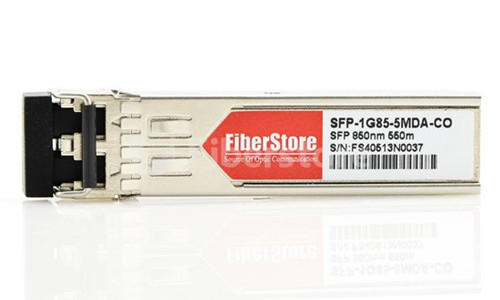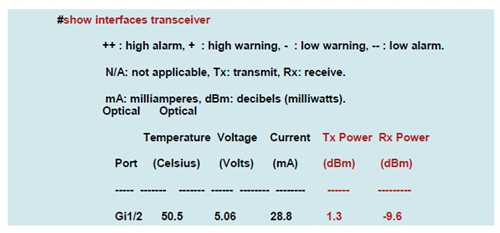If you take a look at the description of a SFP transceiver module, you will see the “DOM support” appeared in the product details. What does it mean? In fact, DOM or Digital Optical Monitoring as the words implies, is used for monitoring some parameters of the transceiver, which can help to identify the location of the fiber link failure, simplify maintenance, improve system reliability. Obviously a SFP with DOM function is high-ender than one without it. This is why most of modern optical SFP transceivers support DOM functions. To have a further understanding of DOM, some detailed information will be introduced in the following passage.
What Is DOM Support?
As noted before, DOM is a feature allowing users to monitor parameters of the transceiver module in real-time, such as temperature, supply voltage, laser bias current as well as transmit and receive optical power. Measurement of these parameters can help network administrators to check and ensure that the module is functioning correctly. Nowadays SFP transceivers are using DOM to perform transceiver monitoring and troubleshooting operation. For example, the DOM function that Cisco GLC-SX-MMD transceiver support can assist network designers in detecting and digitizing parameter signals on circuit board in the inside of this Cisco SFP module. But how to generate DOM function for your optical transceiver?
As noted before, DOM is a feature allowing users to monitor parameters of the transceiver module in real-time, such as temperature, supply voltage, laser bias current as well as transmit and receive optical power. Measurement of these parameters can help network administrators to check and ensure that the module is functioning correctly. Nowadays SFP transceivers are using DOM to perform transceiver monitoring and troubleshooting operation. For example, the DOM function that Cisco GLC-SX-MMD transceiver support can assist network designers in detecting and digitizing parameter signals on circuit board in the inside of this Cisco SFP module. But how to generate DOM function for your optical transceiver?

How to Use DOM
In order to be able to take advantage of DOM capability, both the device and the platform must support the feature. When the transceiver module is DOM-enabled, a minimum software version may be required to support the feature in each platform. And there are five steps you should follow when conducting the DOM function in a SFP module:
In order to be able to take advantage of DOM capability, both the device and the platform must support the feature. When the transceiver module is DOM-enabled, a minimum software version may be required to support the feature in each platform. And there are five steps you should follow when conducting the DOM function in a SFP module:
1. Enable example: Router> enable (Enables the privileged EXEC mode. Enter your password if prompted.)
2. Configure terminal example: Router#configure terminal (Enters the global configuration mode.)
3. Transceiver type all example: Router (config) #transceiver type all (Enters the transceiver type configuration mode.)
4. Monitoring example: Router (config-xcvr-type) #monitoring (Enables monitoring of all optical transceivers.)
5. Monitoring interval example: Router (config-xcvr-type) #monitoring interval 500 ((Optional) Specifies the time interval for monitoring optical transceivers. Valid range is 300 to 3600 seconds, and the default value is 600 seconds.)
2. Configure terminal example: Router#configure terminal (Enters the global configuration mode.)
3. Transceiver type all example: Router (config) #transceiver type all (Enters the transceiver type configuration mode.)
4. Monitoring example: Router (config-xcvr-type) #monitoring (Enables monitoring of all optical transceivers.)
5. Monitoring interval example: Router (config-xcvr-type) #monitoring interval 500 ((Optional) Specifies the time interval for monitoring optical transceivers. Valid range is 300 to 3600 seconds, and the default value is 600 seconds.)
To sum up, these three commands can used to turn on/off DOM for all transceivers type in the system:
- Router (config) #transceiver type all
- Router (config-xcvr-type) #monitoring
- Router (config-xcvr-type) #end
Once enabled, DOM can be accessed via CLI using “show interface transceiver command”. Off all the five values, two mostly used and relevant values are TX and RX power, temperature is also used sometimes. The operating range of these three values is unique across all modules and is available in the data sheet.

Additional Information
DDM and RGD are another two common abbreviations appeared in transceiver modules’ product specifications. So, what does they refer to?
DDM and RGD are another two common abbreviations appeared in transceiver modules’ product specifications. So, what does they refer to?
DDM, short for Digital Diagnostics Monitoring, is a technology used in SFP transceivers in order to give the end user the ability to monitor real-time parameters of the SFPs. Such parameters include optical output power, optical input power, temperature, laser bias current, and transceiver supply voltage etc.
What Is a 'Rugged' (RGD) Transceiver Module?
These are enhanced transceiver modules which have been designed for greater durability, and can operate under more extreme conditions. Rugged transceivers may feature enhanced ESD protection, and extended operating temperature range. Rugged transceiver modules often have "-RGD" in their product number to assist in their identification.
These are enhanced transceiver modules which have been designed for greater durability, and can operate under more extreme conditions. Rugged transceivers may feature enhanced ESD protection, and extended operating temperature range. Rugged transceiver modules often have "-RGD" in their product number to assist in their identification.
Conclusion
After going through this passage, you may have a better understanding of DOM. Before purchasing the SFP transceiver, you should read all the product details carefully because not all the transceivers can support DOM like GLC-LH-SM. Find a reliable vendor will avoid those problems. Fiberstore, as a professional telecommunication manufacturer, is aimed at providing first-class online service and high-quality products to all customers. Our SFP modules are fully compatible with Cisco, Huawei, ZTE, HP, Jumper and other brands.
After going through this passage, you may have a better understanding of DOM. Before purchasing the SFP transceiver, you should read all the product details carefully because not all the transceivers can support DOM like GLC-LH-SM. Find a reliable vendor will avoid those problems. Fiberstore, as a professional telecommunication manufacturer, is aimed at providing first-class online service and high-quality products to all customers. Our SFP modules are fully compatible with Cisco, Huawei, ZTE, HP, Jumper and other brands.
评论
发表评论